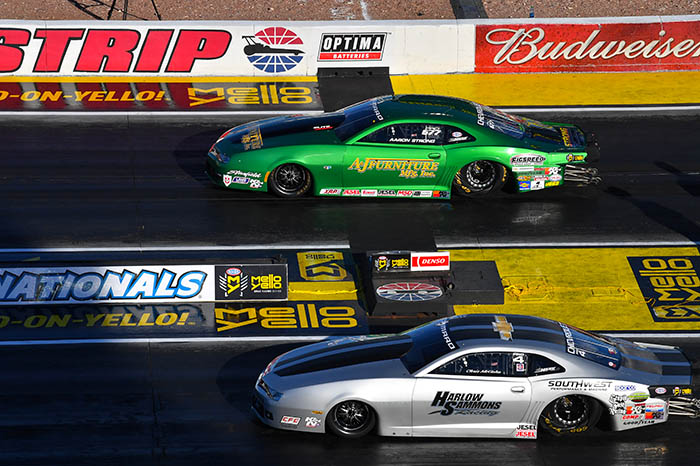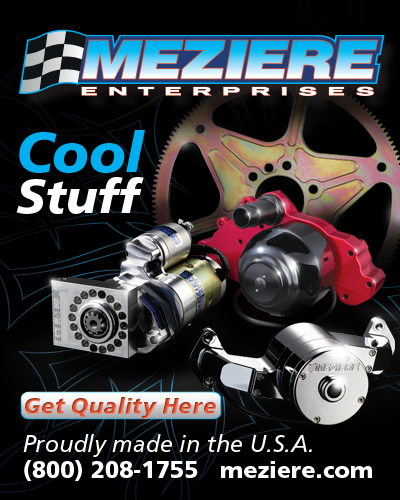LESSER-FUNDED PS TEAMS DISCUSS SEASON OF CHANGE

Wholesale changes to NHRA’s Pro Stock class in 2016 have left low-budget teams fighting to survive.
The source of the financial burden for these part-time teams is the sanctioning body’s rule changes that skyrocketed costs in the short-term for teams to compete.
As of Jan. 1 of this year NHRA required all Pro Stock teams to equip their cars with electronically-controlled throttle body fuel injection systems, making engines more relevant from a technology standpoint. In order to reduce and control costs for the race teams, an NHRA-controlled 10,500 Rev Limiter was added to the fuel injection systems.
“Something needed to change with Pro Stock, but I don’t know if this helped us because we have less teams out here right now and a lot of it is because of what it's going to cost to change over,” said John Gaydosh Jr. “A few of the teams that I know that are on my level, they’re done right now. They have to wait to get some more money together before they can do this.
“We have a lot of money invested in these cars and to make this changeover just for me, and I did everything myself, was about 35 to 40 grand, and that’s most of my budget for the year for parts breakage. It made it tough to put out all that money right away to come out here and hope we don’t break anything right away. It’s OK though. We’re here, we’re playing in their sandbox and lovin’ life and I don’t think I would want to do anything else.”
Gaydosh is right.
These rule changes have not had a Field of Dreams effect for NHRA. They changed the rules and drivers aren’t coming.
The season-opening Winternationals had just enough drivers – 16 – for a full field as did Las Vegas and the Four-Wide Nationals in Charlotte, N.C., last weekend.
However, Phoenix (14), and Gainesville, Fla. (15), didn’t have enough drivers for their respective ladders, resulting in unappealing bye runs during eliminations. That will be the case again at the Spring Nationals at Houston this weekend as there were only 13 Pro Stock drivers entered as of April 26.
Gaydosh Jr., is a former Sportsman racer, who has been competing in NHRA’s Pro Stock class on a limited basis since 2008. He acknowledged departing the class was on the table for discussion.

“That was really one of the biggest decisions we had to make over the winter, whether we were going to continue racing or we were just going to be done,” Gaydosh said. “I’ve really never quit on anything, so I was willing to take that risk and try to see if we can make this work, and so far so good. The only reason we’re out here doing so well, we have to thank the Grays (Gray Motorsports) for that. They’ve really been an assistance to us getting us here and keeping us staying out here with a tune-up.”
Gaydosh has competed at two of the five NHRA races this season – the Gatornationals and Four-Wide Nationals, but he isn’t entered to compete at the Spring Nationals in Houston this weekend.
Kenny Delco, a long-time runner in Pro Stock from the East Coast has competed in 138 Pro Stock national events - winning two.
However, the new Pro Stock rules have left him scrambling. Delco also has just run two races this season, the Gatornationals and Four-Wide Nationals.
“Besides the money, it was pretty tough,” Delco said. “Frank Iaconio did a lot of work on it and a friend of mine, Robert helped, me with the fuel-injection and JCM Racing has helped me. We’ve all been working on it and so far it has been pretty good for us.”
Former Comp racer Aaron Strong, who made his Pro Stock debut last August at the Sonoma (Calif.) Nationals, knew it would be a struggle for him to continue to compete in the revamped Pro Stock class.
His team, however, made the choice to spend money so they could race this season. Strong has ran at two races – the Winternationals and Las Vegas. He also will be at Houston this weekend.
“It’s always going to be harder for a smaller guy no matter what you do,” said Strong, whose team is based in Seattle. “I know it cost us a lot of money to do it, obviously and maybe we could’ve gone to some more races if we hadn’t spent that money switching over. I appreciate and understand what the rules are for and that’s to try and get smaller teams to help get the car count up, I think is what NHRA’s goal was, and right now there are some races in the middle of country like Houston this weekend and Atlanta where they are looking at small car counts. They don’t have the West Coast independent drivers close and the East Coast independent drivers close. It makes it hard for sure.”
To make things work logistically, Strong said he has had to get help from friends.
“We left our rig in Las Vegas with help from our sponsor Les Figueroa at Figspeed,” Strong said. “His speed shop is in Vegas, so he let us keep our rig at his shop and we’ve raced with the Stanfields and Greg Stanfield’s shop in Shreveport, La., is about four hours from Houston, so after we race the Houston race, we will just take our rig over to his shop. We’ve also had A&J Furniture Manufacturing come on as a sponsor and help us, so we’re going to try and do half the (NHRA) schedule. If I could just get enough funding to at least pay for our traveling expenses, I would go to more races.”
If chasing money isn’t hard enough, Pro Stock drivers, especially lesser-funded teams, also have to deal with the fact that Ken Black Racing is dominating the class.
Jason Line (3) and Greg Anderson (2) have combined to win all of the national events. Bo Butner, who also is a teammate to Line and Anderson has two runner-up finishes.

Even though the odds are stacked against him, Gaydosh has no regrets about racing in the new-look Pro Stock class.
“Not at all,” Gaydosh said. “Because you know what, it’s all about finding what you need and we know there’s more left in the car and they know there’s more left in their cars, and so does every other team out here. We just have to dig down and figure out what we need to do. I’m excited about it to tell you the truth because I think I can play once we figure out the car and we get a little bit more power and get some funding. I really think we can make a difference.”
Delco admitted he has one drawback about racing this season – the money it has cost.
“Financially, yes,” said Delco when asked if he had any regrets about switching everything over to continue to race Pro Stock. “Physically, no. It’s a lot of fun. I thought the RPM would help us, which I think it did. The (financial burden) entered my mind, but I sold a few of my older motors to make up the difference. I don’t know about the fuel-injection, but the RPMs was ridiculous to run over 11,000 RPMs. It was just too expensive.”
Strong, meanwhile, does see some positives about the Pro Stock rules shake-up.
“It created a lot of interest and talk about the class,” he said. “I like the fact that something was done I guess more than anything just to create some buzz and get people talking about it. Personally, I think the cars look really good. They look really sleek and do look more like a car you can go down and buy at a dealership. I think the fuel injection is relative to everything in life now with everybody with their iPhones and tablets. I think carburetors are kind of more of an antique part of the motor and I think fuel-injection probably helps the naturally-aspirated motor, giving it kind of an overhaul so it doesn’t become a dinosaur.”





































